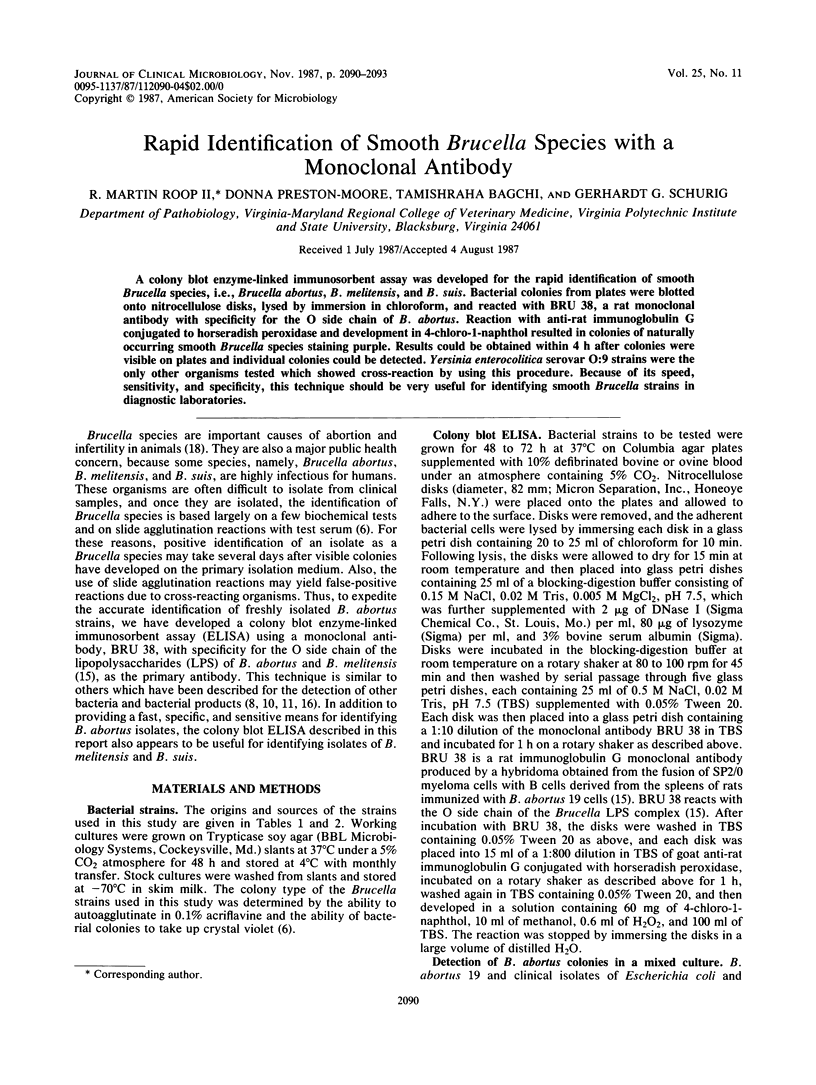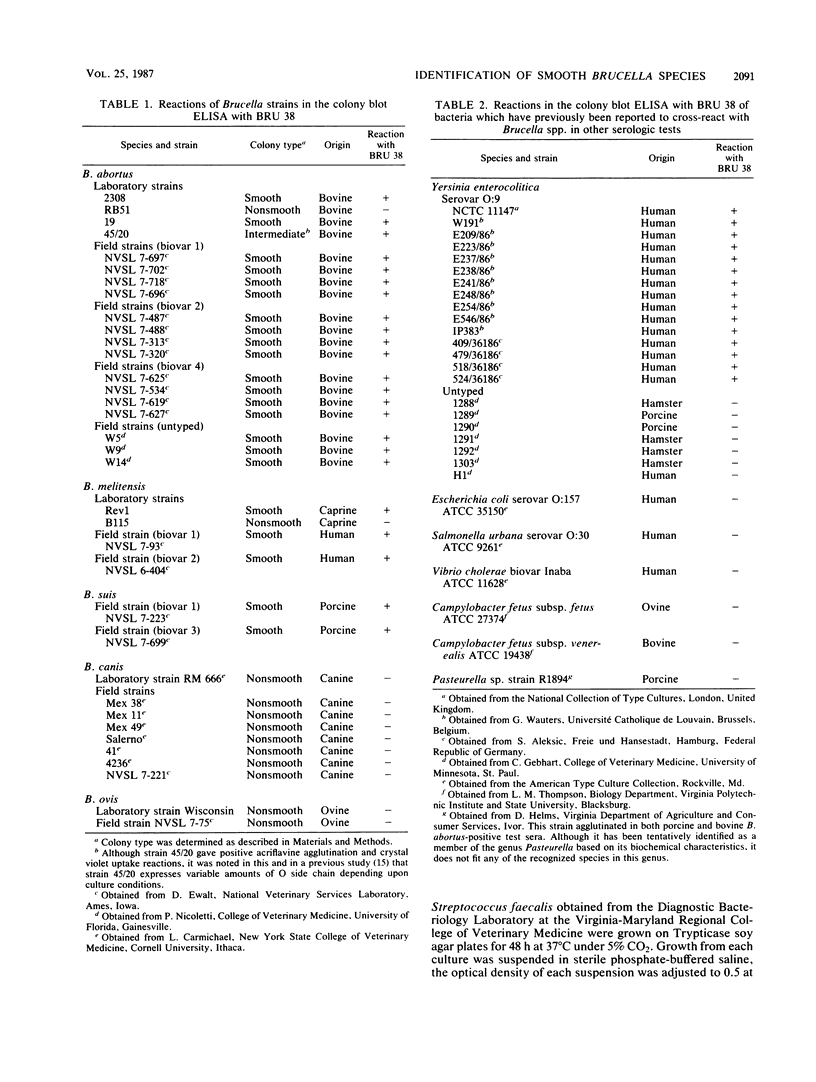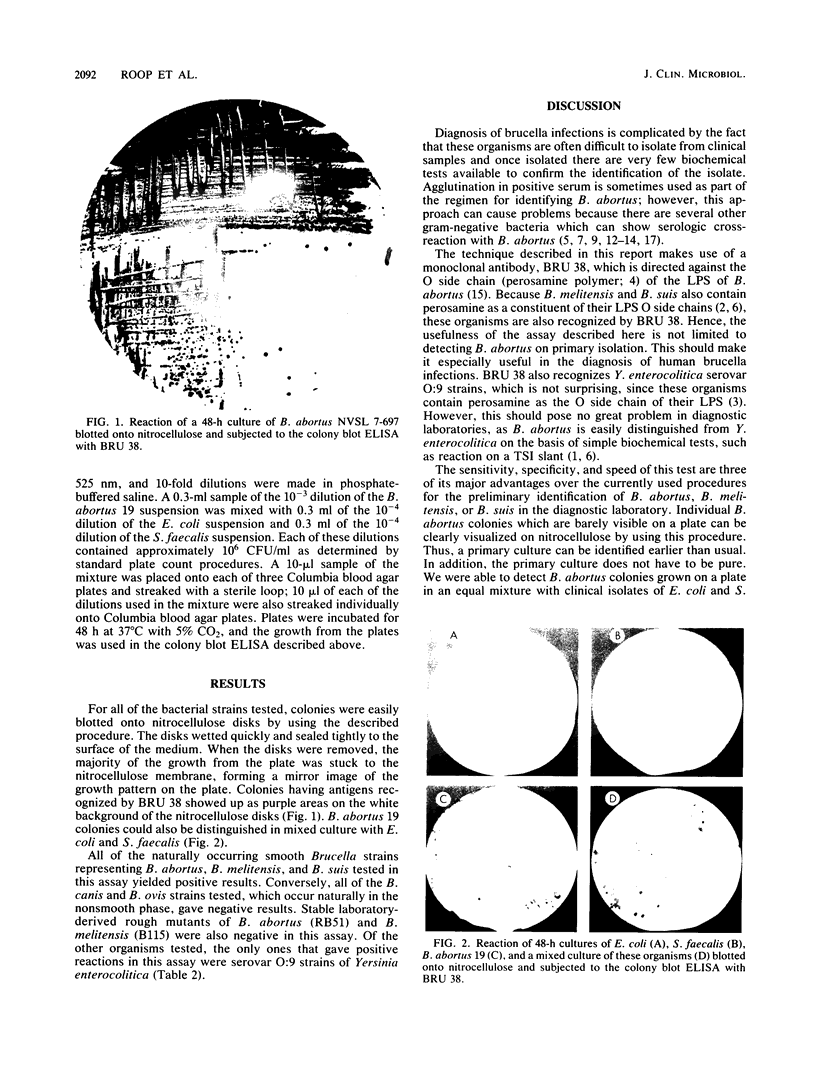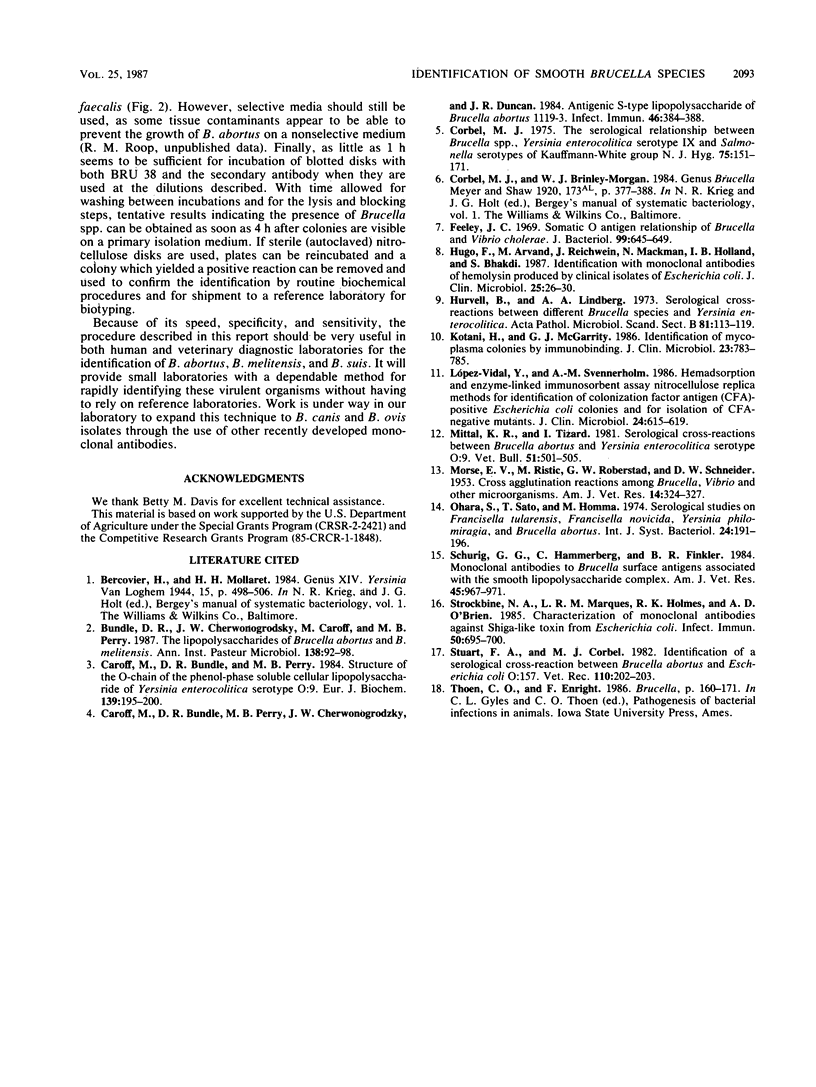Abstract
A colony blot enzyme-linked immunosorbent assay was developed for the rapid identification of smooth Brucella species, i.e., Brucella abortus, B. melitensis, and B. suis. Bacterial colonies from plates were blotted onto nitrocellulose disks, lysed by immersion in chloroform, and reacted with BRU 38, a rat monoclonal antibody with specificity for the O side chain of B. abortus. Reaction with anti-rat immunoglobulin G conjugated to horseradish peroxidase and development in 4-chloro-1-naphthol resulted in colonies of naturally occurring smooth Brucella species staining purple. Results could be obtained within 4 h after colonies were visible on plates and individual colonies could be detected. Yersinia enterocolitica serovar O:9 strains were the only other organisms tested which showed cross-reaction by using this procedure. Because of its speed, sensitivity, and specificity, this technique should be very useful for identifying smooth Brucella strains in diagnostic laboratories.
Full text
PDF



Images in this article
Selected References
These references are in PubMed. This may not be the complete list of references from this article.
- Bundle D. R., Cherwonogrodzky J. W., Caroff M., Perry M. B. The lipopolysaccharides of Brucella abortus and B. melitensis. Ann Inst Pasteur Microbiol. 1987 Jan-Feb;138(1):92–98. doi: 10.1016/0769-2609(87)90083-4. [DOI] [PubMed] [Google Scholar]
- Caroff M., Bundle D. R., Perry M. B., Cherwonogrodzky J. W., Duncan J. R. Antigenic S-type lipopolysaccharide of Brucella abortus 1119-3. Infect Immun. 1984 Nov;46(2):384–388. doi: 10.1128/iai.46.2.384-388.1984. [DOI] [PMC free article] [PubMed] [Google Scholar]
- Caroff M., Bundle D. R., Perry M. B. Structure of the O-chain of the phenol-phase soluble cellular lipopolysaccharide of Yersinia enterocolitica serotype O:9. Eur J Biochem. 1984 Feb 15;139(1):195–200. doi: 10.1111/j.1432-1033.1984.tb07994.x. [DOI] [PubMed] [Google Scholar]
- Corbell M. J. The serological relationship between Brucella spp., Yersinia enterocolitica serotype IX and Salmonella serotypes of Kauffmann-White group N. J Hyg (Lond) 1975 Aug;75(1):151–171. doi: 10.1017/s0022172400047173. [DOI] [PMC free article] [PubMed] [Google Scholar]
- Feeley J. C. Somatic O antigen relationship of Brucella and Vibrio cholerae. J Bacteriol. 1969 Sep;99(3):645–649. doi: 10.1128/jb.99.3.645-649.1969. [DOI] [PMC free article] [PubMed] [Google Scholar]
- Hugo F., Arvand M., Reichwein J., Mackman N., Holland I. B., Bhakdi S. Identification with monoclonal antibodies of hemolysin produced by clinical isolates of Escherichia coli. J Clin Microbiol. 1987 Jan;25(1):26–30. doi: 10.1128/jcm.25.1.26-30.1987. [DOI] [PMC free article] [PubMed] [Google Scholar]
- Hurvell B., Lindberg A. A. Serological cross-reactions between different Brucella species and Yersinia enterocolitica. Immunochemical studies on phenol-water extracted lipopolysaccharides from Brucella abortus and Yersinia enterocolitica type IX. Acta Pathol Microbiol Scand B Microbiol Immunol. 1973 Feb;81(1):113–119. [PubMed] [Google Scholar]
- Kotani H., McGarrity G. J. Identification of mycoplasma colonies by immunobinding. J Clin Microbiol. 1986 Apr;23(4):783–785. doi: 10.1128/jcm.23.4.783-785.1986. [DOI] [PMC free article] [PubMed] [Google Scholar]
- López-Vidal Y., Svennerholm A. M. Hemadsorption and enzyme-linked immunosorbent assay nitrocellulose replica methods for identification of colonization factor antigen (CFA)-positive Escherichia coli colonies and for isolation of CFA-negative mutants. J Clin Microbiol. 1986 Oct;24(4):615–619. doi: 10.1128/jcm.24.4.615-619.1986. [DOI] [PMC free article] [PubMed] [Google Scholar]
- MORSE E. V., RISTIC M., ROBERTSTAD G. W., SCHNEIDER D. W. Cross-agglutination reactions among Brucella, Vibrio, and other microorganisms. Am J Vet Res. 1953 Apr;14(51):324–327. [PubMed] [Google Scholar]
- Schurig G. G., Hammerberg C., Finkler B. R. Monoclonal antibodies to Brucella surface antigens associated with the smooth lipopolysaccharide complex. Am J Vet Res. 1984 May;45(5):967–971. [PubMed] [Google Scholar]
- Strockbine N. A., Marques L. R., Holmes R. K., O'Brien A. D. Characterization of monoclonal antibodies against Shiga-like toxin from Escherichia coli. Infect Immun. 1985 Dec;50(3):695–700. doi: 10.1128/iai.50.3.695-700.1985. [DOI] [PMC free article] [PubMed] [Google Scholar]
- Stuart F. A., Corbel M. J. Identification of a serological cross-reaction between Brucella abortus and Escherichia coli 0:157. Vet Rec. 1982 Feb 27;110(9):202–203. doi: 10.1136/vr.110.9.202-a. [DOI] [PubMed] [Google Scholar]




